Tukultī-Ninurta I
Quick links
Introduction
Military and political history
Building projects
Internal opposition and death
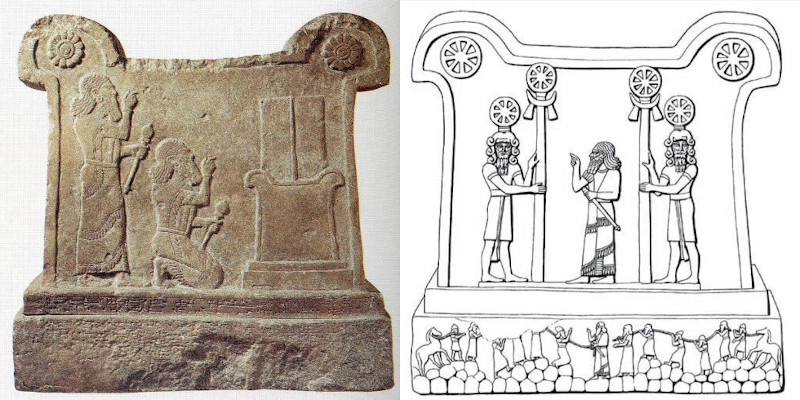
See text no 27
Introduction
Tukultī-Ninurta I (1243-1207 BC), was, according to the Assyrian King List Assyrian King List [/riao/kinglists/assyriankinglist/assyriankinglist/index.html#MiddleAss], the seventy-eighth ruler of Ashur, who reigned for thirty-seven years. He was son and successor of Shalmaneser I [/riao/thekingdomofassyria13631115bc/shalmaneseri/index.html] and grandson of Adad-nārāri I [/riao/thekingdomofassyria13631115bc/adadnararii/index.html], and predecessor of Aššur-nādin-apli [/riao/thekingdomofassyria13631115bc/ashurnadinapli/index.html]. In a literary text belonging to the so-called "Chedorlaomer Texts" the name of Tukultī-Ninurta occurs twice, both times written cryptographically mBÀD.MAḪ-dMAŠ A/DUMU ša mÌR-é-TUŠ.A, read by Lambert (2004:201) as "Tukultī-Ninurta, son of Arad/Ardi-(E)saggil" and of a slave girl. As pointed out by Lambert (and more recently by Streck 2014-2016:177) this is probably an Elamite propagandistic reconstruction of the supposed Babylonian origins of the king.
Benjamim R. Foster describes Tukultī-Ninurta I as a "tragic and fascinating Assyrian king" (Foster 2005:298), a definition justified by different peculiarities that characterized his reign. He was the last and possibly greatest of thirteenth-century Assyrian kings, under whose reign Assyria reached unprecedented territorial extension and international power. During his reign he obtained important conquests in Syria, Anatolia and southern Mesopotamia against the Hittite kingdom and Babylonia. As a consequence of his southern conquests, the ruler promoted Babylonian scribal and religious culture, improving greatly its impact on Assyria for the centuries to come. This is often seen as one of the causes of frictions and growing malcontent among Assyrian aristocracy, which will eventually end up with his assassination by hand of one of his own sons (Aššur-nādin-apli). He is also known for an impressive building production, including temple and palaces in the cities Ashur and Nineveh and a newly founded capital named afetr himself Kār-Tukultī-Ninurta "Port Tukultī-Ninurta."
Tukulti-Ninurta I is also attested in the following later royal inscriptions:
Tiglath-pileser I (1114-1076 BC) text no. 4 [/riao/Q005929/] as the original builder of the houses of šaḫūru and labūnu in the Palace of Ashur;
Aššur-bel-kala (1073-1056 BC) text no. 7 [/riao/Q005988/], as the builder oft he New Palace of Ashur;
Adad-nērāri II (911-891 BC) text no. 2 [/riao/Q006021/], in annalistic context as the moment since when the cities Sikkur (and) Sappānu, in northern Mesopotamia, had withheld tax (and) tribute from Aššur;
Shalmaneser III (858-824 BC) text no. 26-27 [/riao/Q004631,Q004632/], as builder of the city wall of Ashur, and text no. 49-51 [/riao/Q004654,Q004655,Q004656/], as builder of the temple of Šarrat-nipḫi;
Adad-nērāri III (810-783 BC) text no. 1 [/riao/Q004749/], as part of the long genealogy of the ruler dating back to Sulilu [/riao/fromcolonytocitystate23341809bc/sargonicanduriiiperiods/sulilu/index.html].
Finally, Sennacherib (704-681 BC) text no. 156 [http://oracc.museum.upenn.edu/rinap/Q003961/], is small tablet on which three inscriptions originally engraved on the same royal seal of lapis lazuli are copied. The seal originally belonged to the king of Babylonia Šagarakti-Šuriaš, was then seized as booty by Tukultī-Ninurta, returned to Babylonia and was retaken as booty by Sennacherib in 689.
Military and political history

See text no 13
Tukultī-Ninurta inherited from his predecessors a kingdom that already controlled much of northern Mesopotamia, which he contributed to make more stable and to extend with a series of successful military campaigns. Apart from campaigns in the north-east and the north (Qumānu and Šubartu), the two major fronts of Tukultī-Ninurta's military undertakings were Ḫatti in the north-west and Babylonia in the south.
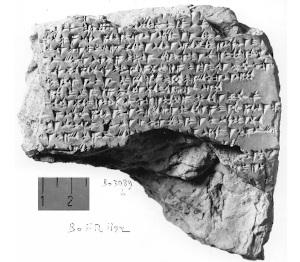
KBO 23.92 (CTH 178 [https://www.hethport.uni-wuerzburg.de/hetkonk/hetkonk_abfrage.php?c=178]) (source Hethitologie Portal Mainz)
One can follow a good part of the developing political relationships between Assyria and Ḫatti from different sources, including non-Assyrian ones: the friendly letters (but most probably preliminary drafts, CTH 178, especially KUB 23.92, 23.103, see Mora and Giorgieri 2004:155-158) sent by the Hittite ruler Tutḫaliya IV to Tukultī-Ninurta and his magnates at the beginning of the Assyrian king's reig; texts from Ugarit (RSOu 7, 46) and Ḫattuša (KBo. 4, 14), documenting the first confrontations between the two polities which brought to the battle of Naḫriya and Hittites' defeat; a peace treaty concluded at Kumaḫu (KBo. 18, 28+); a second conflict with Ḫanigalbat and Charchemish (KBo. 18, 28+; 25(+); cf. BATSH 10, 2), which ended through negotiations between the two kings (KBo. 18, 28+; KUB 3, 73), and probably followed by a second peace treaty.
The outcome of his Hitite wars is constantly present in his royal inscriptions, as in text no. 1 (ii 14-iii 3):
Mention of deportation of Hittite people to Assyria is present, curiously, only in two later texts (nos. 23: 28-30, and 24:23-25 "I uprooted 28,800 Hittite people from "Beyond the Euphrates" and led (them) into my land")
In Babylonia Tukultī-Ninurta captured Kaštiliašu IV and brought him and his family to Assyria (letter BATSH 4/1, 10 might attest the Babylonian ruler and his Kassite women accompanying Tukultī-Ninurta in his visit to Dūr-Katlimmu). Although Tukulti-Ninurta claimed ultimate power over Babylonia by adopting the titles 'king of Karduniaš' and 'king of Sumer and Akkad', he did not take the title of king of Babylon for himself and instead appointed one Enlil-nādin-šumi as puppet ruler of Babylonia and, after him, Kadašman-Ḫarbe II and Adad-šum-iddin. When the latter was deposed, Tukultī-Ninurta invaded Babylon, destroyed its walls, deported the statue of Marduk and took control over the city for seven years.
The kidnapping of the image of Marduk – which was going to be treated with great respect in its Assyrian captivity – is but one of a series of acts that can be labelled as "cultural looting" of Babylonia, to which belongs as well the taking of hundreds of scholarly and literary manuscripts from the city's libraries – along with a number of learned scribes. These were not simply brought to Assyria, but became a source of cultural development marking a pivotal moment in the intellectual history of the land (Heeßel 2012:12-15). The text belonging to the Babylonian libraries have since long been recognized (Weidner 1952: 200; and discussion in Heeßel 2011), as well as their importance in initiating a previously unknown interest in the divinatory activity in Assyria, which from now on will become a key method of decision making for all future kings (Radner 2011). The presence of learned Babylonian scribes in the ruler's entourage is then evidenced by the improvement of quality in literary production, visible – outside the royal inscriptions repertoire – in refined compositions like a bilingual prayer in Sumerian and Akkadian (KAR 128+129/1,2 = Foster 2005:318-323 "Psalm to Assur for Tukultī-Ninurta I").
Probably the highest example of literary production of this period, the "Epic of Tukultī-Ninurta" narrates the events of the Babylonian campaign, and represents a mature synthesis of Assyrian (see, the "Epic of Adad-nārāri I") and Babylonian traditions. No longer or more complex composition of historical poetry was ever done in Assyria, and the work was found in copies from diverse periods and geographical region, from Ashur and Nineveh to Ugarit, and from the Midlle to the Neo-Assyrian times (Machinist 2014).
Building projects
(Text no. 13: 24-50)
Tukultī-Ninurta's led an impressive number of building enterprises within Ashur, as well as in other cities. The inscriptions attest that after having lived for a while in the "Old Palace" of Ashur, the ruler built a new one reconstructing an old palace of Shalmaneser I, his father (texts nos. 1-10, 30; see also discussion in Streck 2007, 156-158), wall and moat (no. 19), the Aššur temple (no. 26), and the temples of Ištar (finishing the restoration started by his grandfather Adad-nārāri I [/riao/thekingdomofassyria13631115bc/adadnararii/index.html], nos. 11-16), Ninuaʾītu (= Ištar, no. 17), Sîn-Šamaš (no. 18); at Nineveh, were he worked on the temple of Ištar.
The new capital Kār-Tukultī-Ninurta
Finally, sometimes after the conquest of Babylon and the capture of Kaštiliaš IV, around his eleventh regnal year (1231 BC), Tukultī-Ninurta founded his new capital at Kār-Tukultī-Ninurta. According to his inscriptions (nos. 22-25, 35-37), the king did so according to a request from the god Aššur, who wanted a new cult center for himself on the left bank of the Tigris, about three kilometres north of Ashur.
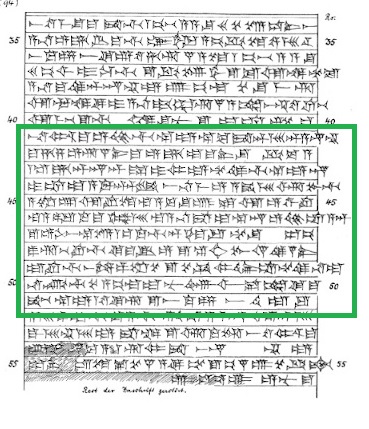
See Text no. 24
(Text no. 24 [/riao/Q005860/]: 41-52)
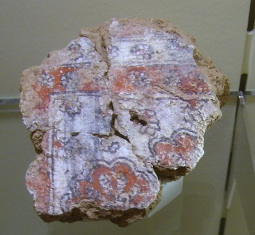
Fragment of a wall painting from the palace a Kar-Tukulti-Ninurta (from Wikipedia [https://en.wikipedia.org/wiki/Kar-Tukulti-Ninurta#/media/File:Assyrian_painting.JPG])
The site of the city (mod. Tulūl al-ʿAqar, 100 km south of Mosul) was excavated from 1913 to 1914 by the Deutsche Orient-Gesellschaft, under the lead of Walter Bachmann, who also worked at Ashur. The fortified area extended for ca. 600 sqm, and a wall in the middle of the city divided it in two parts. In the western part was the temple of Aššur (Ekurmešarra [/riao/Q005859.109/]) with his ziqqurrat, where text no. 24 (see image) was discovered. North of the temple was the royal palace (Egalmešarra [/riao/Q005858.9/], placed on a platform ca. eighteen meter (no. 22: 49 "120 layers of brick") high. The palace, whose remains are lost, was decorated with wall paintings, of which many samples have been found during the excavations of the site (Eickhoff 2014-2016).
Internal opposition and death
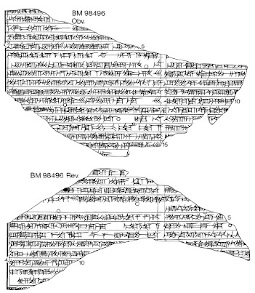
Tukultī-Ninurta's bilingual BM 98496, Iraq 38, p. 93
Tukultī-Ninurta is well known for having been a king as much successful as opposed by the aristocracy, an alienation that ended with his assassination in his palace in Kār-Tukultī-Ninurta, where he had spent most of his last years of reign (Foster 2005:211).
Among the reason of the aristocracy's alienation of Tukultī-Ninurta, modern scholars count the carrying of Marduk's statue to Assyria after the sack of Babylon (and the reverence practiced to it), an act that might have been perceived as sacrilegious by many, and the foundation of the new capital named after himself. A fascinating text, under this perspective, is the bilingual BM 98496 (Sumerian and Akkadian), in which the Tukultī-Ninurta (whose name does not appear, but there is little doubt that the text belongs to him) "uses" the Assyrian King List to prove his supremacy as ruler and favourite of Aššur in respect to his predecessors (including his own dynasty!). The text reading is difficult because of the predominance of a Sumerian of artificial rendering based on the lost Akkadian text, but the discourse seems clearly aimed at preaching Tukultī-Ninurta's contemporaries and posterity such message of superiority: during his office the offerings to the gods were increased and the practice of justice was "born" (Lambert 1976).
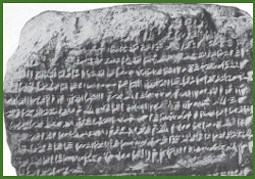
A portion of Chronicle P (BM 92701) referring to the events surrounding the reign of Tukulti-Ninurta I (from Wikipedia [https://en.wikipedia.org/wiki/Chronicle_P]).
Ironically, the same Assyrian King List, mitigates the death of the king, although confirming that it was by the hand of his son Aššur-nādin-apli (not Aššur-nāṣir-apli, see Yamada 1998), by describing it with the laconic record that his reign "had lasted too long," and in this way reducing ideologically the crisis represented by the episode to a mere incident in the otherwise monolithic dynastic continuity that the lists artificially represents. A different – apparently closer to reality, but clearly not immune from bias – report on his death comes form Chronicle P (TCS 5, p. 176 Chr. 22) iv 9-11.
Browse the RIAo Corpus [http://oracc.museum.upenn.edu/riao/pager/]
Bibliography
Nathan Morello
Nathan Morello, 'Tukultī-Ninurta I', The Royal Inscriptions of Assyria online (RIAo) Project, The RIAo Project, a sub-project of MOCCI, 2020 [http://oracc.museum.upenn.edu/riao/thekingdomofassyria13631115bc/tukultininurtai/]